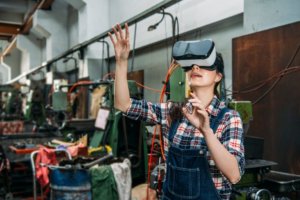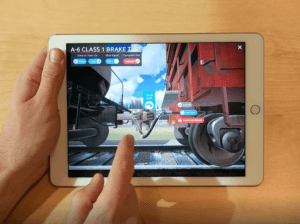 Simulated experiences are often perceived as ‘escapes from reality.’ But this is far from an accurate assessment, as research has proved that simulations offer an enhanced experience particularly when it comes to training.
Simulated experiences are often perceived as ‘escapes from reality.’ But this is far from an accurate assessment, as research has proved that simulations offer an enhanced experience particularly when it comes to training.
This piece seeks to shift thinking toward what’s possible, by sharing how and why simulations are being designed and deployed for businesses today, and to arm advocates with use cases that will have team members at your next planning meeting paying close attention.
Moving from Classroom to Cloud
Traditional training methods hadn’t advanced much beyond typical models until recently. They depended largely on in-person training, led by instructors and evaluated via written and/or hands-on tests. These trainings required businesses to take equipment out of commission to have it available for practice, while also paying qualified instructors to teach, and then there were corresponding time/travel costs for everyone involved to participate in these offerings. Assessment was another area found lacking, with students immediately evaluated and often in isolation, removed from in-the-moment scenarios for safety, but missing out on critical thinking opportunities to solidify training – and providing little hope for that learning to stay with students long-term.
Computers offered learners a visual enhancement with eLearning, or computer-based training (CBT). eLearning came with a degree of portability, but it was boring. Very boring. It has evolved over time, from reading a bunch of slides and answering set questions at the end of each unit section, to more individualized options, where readings and videos are offered in response to a participant’s correct/incorrect responses, identifying and filling gaps in knowledge. It was still a passive option though, until simulations came along.
Simulations for Learning & More
A simulated VR experience is a powerful tool, and one that will soon be as ubiquitous as computers in the workplace – and just as valuable, particularly when there are dangerous situations to train for: “The virtual environments also make possible training with hazardous materials or dangerous situations without being in real danger. How else can an airplane pilot train for an engine-failure situation or nuclear plant personnel train for a leak involving nuclear waste?”
How, indeed. Hazard prevention and control protocols are specific and dependent upon job function, with additional requirements for emergencies and non-routine scenarios. Having a plan in place, one that every employee has memorized, is great; but having employees who have also trained on these precise scenarios in a simulated environment is so much better. They’ll remember what they’ve done – 90% of it. And when emergencies happen, or even run-of-the-mill repairs are required, you’ll be glad for that ROI.
 Speaking of ROI, beyond a high retention rate, there’s also reduced training and repair costs to keep in mind. While the initial spend to set up virtual simulated training takes up a bit of your budget, the training is entirely portable and requires very little beyond a mobile or portable device – there are no travel costs, no equipment to take out of commission to train employees on and that 90% retention rate means less time and money lost to rectify costly mistakes.
Speaking of ROI, beyond a high retention rate, there’s also reduced training and repair costs to keep in mind. While the initial spend to set up virtual simulated training takes up a bit of your budget, the training is entirely portable and requires very little beyond a mobile or portable device – there are no travel costs, no equipment to take out of commission to train employees on and that 90% retention rate means less time and money lost to rectify costly mistakes.
Also, once businesses try it, it’s addicting in its own right. Not as addictive as gaming, for sure, but that isn’t your end goal regardless. Having employees show up early for brake inspection training is pretty telling, as Norfolk Southern shared about its own adoption of simulated training:
“The level of engagement has been a surprise.
An instructor observed a conductor training with the simulation before class even started.”
Try to find employees showing up early for a day of traditional training, with someone set to talk at them for hours on end. Or look for those logging in to complete extra hours on that CBT refresher required every six months. Unlikely.
So why aren’t all businesses creating simulated trainings for their technicians? They may confuse it with gaming or CBTs – or just not value the importance of “learning by doing.” A bit around the psychology of learning might help:
The Psychology of Learning
Learning something new takes effort. So why do we breeze through and readily remember some things and suffer to retain others? And why is gaming so attractive but reading for its own reward is not? If you’ve explored a bit about how the brain learns, you may assume dopamine play a large role in retention. And according to some neuroscientists, you’d be correct.
As Tom Maddox, PhD shared, “during Immediate Feedback Training the learner is immersed in an environment and they are asked to elicit some to-be-trained behavior. Feedback regarding the correctness of their behavior follows immediately. If the behavior was performed correctly, the relevant neural connections are strengthened and that behavior will be more likely to occur next time. If the behavior was performed incorrectly, the relevant neural connections are weakened and that behavior will be less likely to occur next time. This strengthening and weakening is controlled by the neurotransmitter, dopamine. The learning is fast, robust and long lasting.”
 Observational training, on the other hand, does not illicit a behavior but can immerse a learner in an experience, trigger the same dopamine release and be valuable as well, depending on the desired outcome. But when we know that learners remember 90% of what they DO, 70% of what they say or write, 50% of what they see or hear and 10% of what they read, the choice for training seems clear.
Observational training, on the other hand, does not illicit a behavior but can immerse a learner in an experience, trigger the same dopamine release and be valuable as well, depending on the desired outcome. But when we know that learners remember 90% of what they DO, 70% of what they say or write, 50% of what they see or hear and 10% of what they read, the choice for training seems clear.
And although both immediate feedback and observational training are said to offer comparable affects depending on the task to be learned, according to this study on dopamine’s effects, “in terms of functional consequence, dopamine release is not required for normal learning to proceed.” So why are we even worried about dopamine anyway? “Even if dopamine activation occurs during reward learning, perhaps partly as a conditioned motivational response of the brain, dopamine is not a necessary cause for that learning to occur. This is a difference that seems to matter to the brain, and so it should matter to neuroscientists too.”
Granted, this study focused on the brain of a caffeinated dopamine-deficient (DD) mutant mouse, but are we really that dissimilar any Monday morning? The results of the study are interesting though, and offer a telling answer to “What does dopamine do?” Answer: “Confuse neuroscientists.” – But what isn’t confusing – at risk of being repetitive: We learn by doing. And simulated virtual learning does an exceptional job of not only replicating but creating an immersive reality.
But, you may think – this is great for Millennials or younger workers, but what do I do about older employees who aren’t technologically savvy?
Bridging Generational Gap with Simulations
 Since ancient times, humanity’s advancements have hinged on our ability to pass down knowledge from one generation to the next. Oral histories, often acted out by those sharing them, gave way to written communications – and although the latter offered a more permanent solution, something gets lost in translation. Written documents could be subjective, with readers potentially glossing over parts that may be key to understanding, or, as we spoke to above, not retaining what they’ve merely read in their long-term memory at all.
Since ancient times, humanity’s advancements have hinged on our ability to pass down knowledge from one generation to the next. Oral histories, often acted out by those sharing them, gave way to written communications – and although the latter offered a more permanent solution, something gets lost in translation. Written documents could be subjective, with readers potentially glossing over parts that may be key to understanding, or, as we spoke to above, not retaining what they’ve merely read in their long-term memory at all.
So should we have our master technicians acting out the proper repair of a complicated piece of machinery, a course really built for apprentice learners? Might be overkill. But we can make it accessible to them, in case a refresher is required – and wrap it up in intuitive immersive technology.
“Simulation software and immersive technology have a game-like feel, which appeals to the Millennial generation,” says Stephanie Neil in Automation World. Meanwhile, Baby Boomers can teach as they’ve always learned: through active participation. Trial and error with workers from a variety of age groups shows that simulated training is accessible and effective for all. And “ultimately, VR in education will revolutionize not only how people learn but how they interact with real-world applications of what they have been taught. Imagine medical students performing an operation or geography students really seeing where and what Kathmandu is. The world just opens up to a rich abundance of possibilities.”
And this is already happening. We’ve been sharing a series of tech talks, documenting advances in simulated technology spanning a stunning variety of verticals, and invite you to explore them!
Other Training Methods – Do We Still Need Them?
Aren’t there other ways to train that get the job done and don’t cost as much up front? Do we really need to hop on every technological bandwagon that passes by? Yes and no. Existing methods actually cost more long-term, as discussed – and virtual reality is far from new and untested territory at this point. Jumping on the augmented reality bandwagon would be premature, but as of this writing, virtual reality has certainly proved its mettle.
But that doesn’t mean you should throw out the baby with the bathwater either. Early adopters, like Norfolk Southern have shifted focus to identifying which type of simulation to deploy next.
“We don’t want to overwhelm our employees with technology.
We still want them to go out there and get their hands dirty.”
And armed with an iPad, complete with interactive refresher training, their workforce can do just that.
Simulated virtual training and the like is a global market attracting billions, and businesses seeking to diversify their offerings and fine tune their trainings for maximum ROI makes sense. And following what works best for task retention to inform that decision doesn’t require having a neuroscientist on staff, not even close!
We have some fairly well versed folks available to advise you. Reach out here now and we’ll happily provide insight around your specific situation. And maybe consider these questions ahead of that call, to help frame the discussion.


